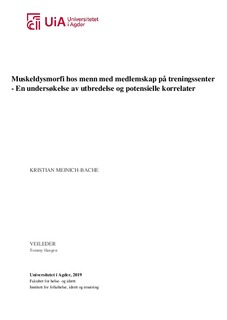| dc.description.abstract | Purpose: The purpose of the present study was to examine the prevalence of muscle dysmorphia in a sample of men aged 16-40 years old with a Norwegian gym membership. In addition, the purpose was to investigate the relationship between muscle dysmorphia and age, body mass index, strength training duration, eating concern, percentage of protein intake, intake of protein supplements, intake of creatine supplements and training day/rest day. Method: A total of 1320 men recruited from physical attendance at gyms (n = 312), and through social media (n= 1008), participated in the study. The study was conducted by using a quantitative research design where data was collected by using a questionnaire. A standardized questionnaire named The Muscle Dysmorphic Disorder Inventory (MDDI) was used to examine the prevalence of muscle dysmorphia. The analyses were performed separately for the two samples by using SPSS and a crosstab, a correlation matrix and a regression model were constructed. Results: The study showed a prevalence of muscle dysmorphia of 35 % in the total sample based on MDDI cut-off score. The gym sample showed muscle dysmorphia prevalence rates of 21.2 % and the social media sample revealed prevalence rates of 39.3 %. Higher symptoms of muscle dysmorphia were associated with lower age and intake of protein supplements in the gym sample, whereas in the social media sample, symptoms of muscle dysmorphia were positively associated with body mass index, strength training duration, eating concern, and intake of both protein and creatine supplements. Conclusion: The present study indicates that muscle dysmorphia is present among men in Norwegian gyms, in line with other populations. In addition, analogous to previous research, this study demonstrates that muscle dysmorphia is associated to several aspects. Future research should acquire a wider and deeper understanding of muscle dysmorphia worldwide and in a Norwegian context. Keywords: Muscle Dysmorphia, Muscle Dysmorphic Disorder Inventory, prevalence, correlates, gym, social media | nb_NO |

